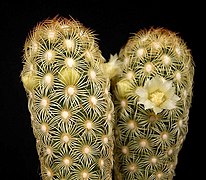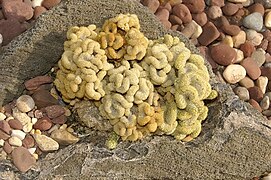Mammillaria elongata
| Mammillaria elongata | |
|---|---|

| |
| Scientific classification | |
| Kingdom: | Plantae |
| Clade: | Tracheophytes |
| Clade: | Angiosperms |
| Clade: | Eudicots |
| Order: | Caryophyllales |
| Family: | Cactaceae |
| Subfamily: | Cactoideae |
| Genus: | Mammillaria |
| Species: | M. elongata
|
| Binomial name | |
| Mammillaria elongata DC.
| |
Mammillaria elongata, the gold lace cactus or ladyfinger cactus, is a species of flowering plant in the family Cactaceae, native to central Mexico. Growing to 15 cm (6 in) tall by 30 cm (12 in) wide, it consists of densely packed clusters of elongated oval stems, covered in harmless (although very sharp) yellow or brown spines, and in spring producing white or yellow flowers. It is among the most common and most variable of its genus in nature, and is a popular subject for cultivation.[1][2] It has gained the Royal Horticultural Society's Award of Garden Merit.[3][4]
Description
The cactus forms dense groups of cylindrical, erect or semi-prostrate stems about 6 to 15 cm long and 1.5 to 3.7 cm in diameter. Its body, bright green, is formed by short conical tubercles (2 to 4 mm) ending in round and woolly areoles in the young segments, unlike tubercular axils that lack wooliness. It has between 15 and 30 short radial spines (6 to 12 mm), curved outwards that intersect with those of the nearby areoles and 1 to 3 central (sometimes absent) yellow or golden color. The flowers arise on the upper part of the stems and are 1.5 cm in length and diameter, with pale yellow or white toothed petals, sometimes with a darker or reddish central line. The fruits are cylindrical to globose, brown or red, with a large number of seeds. Blooms profusely between late winter and early summer.
Cultivars
- Golden Stars
- "Copper King"
- "Cristata" (Brain Cactus)
- "Julio"
-
flowers
-
Mammillaria elongata
-
Top view of Lady finger cactus
-
Brain cactus, Mammillaria elongata Cristata
References
- ^ RHS A-Z encyclopedia of garden plants. United Kingdom: Dorling Kindersley. 2008. p. 1136. ISBN 978-1405332965.
- ^ "Cactus Art - Mammillaria elongata". Retrieved 26 June 2013.
- ^ "RHS Plant Selector - Mammillaria elongata". Retrieved 3 January 2021.
- ^ "AGM Plants - Ornamental" (PDF). Royal Horticultural Society. July 2017. p. 63. Retrieved 3 April 2018.
- Maria Papafotiou, George N. Balotis, Panayiota T. Louka and John Chronopoulos, (2004) In vitro plant regeneration of Mammillaria elongata normal and cristate forms, Volume 65, Number 2.
External links
 Media related to Mammillaria elongata at Wikimedia Commons
Media related to Mammillaria elongata at Wikimedia Commons Data related to Mammillaria elongata at Wikispecies
Data related to Mammillaria elongata at Wikispecies




